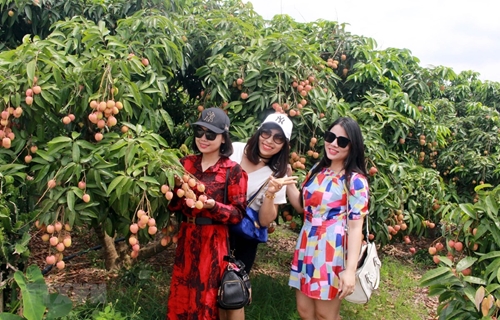Local authorities will focus from now to the end of the year on directing relevant agencies to speed up investment projects in tourism, especially spiritual tourism, eco-tourism, cultural and historical tourism, entertainment tourism, and agriculture-linked tourism.
    |
 |
|
Tourists visiting lychee garden in Bac Giang (Photo for illustration) |
It is also working to increase links with neighbouring cities and provinces such as Hanoi, Quang Ninh, Bac Ninh, Hai Duong, Thai Nguyen, and Lang Son.
The province has already developed community-based tourism this year, in Son Dong, Yen The, and Luc Ngan districts, while promoting tours to popular destinations such as the Truc Lam Zen Buddhist area in the Tay Yen Tu region.
Affected by the COVID-19 pandemic, the number of tourists to Bac Giang in the first half was estimated at 502,000, a year-on-year decline of 67.7 percent.
The sector earned some 179 billion VND (7.7 million USD) in revenue, down 32 percent against the same period last year.
To overcome the difficulties, Bac Giang launched a programme stimulating domestic travel, completed a tourism connectivity map between itself and Bac Ninh and Hai Duong, and allowed 70 businesses to open tours exploring the sacred land of Tay Yen Tu.
The provincial People’s Committee approved an investment policy last February for six tourism development projects worth over 2.54 trillion VND (109.8 million USD), including the Tay Yen Tu spiritual and eco-tourism project.
Located in the Lang Son-Hanoi-Hai Phong-Quang Ninh economic corridor and bestowed with stunning natural landscapes like Tay Yen Tu Natural Reserve, Khe Ro primeval forest, Dong Cao plateau, and Khuon Than lake, Bac Giang province poses huge potential to build various kinds of tourism products.
Endowed with favourable climate, stable geology and rich soil, this land is a home for Kinh Bac culture development, essence of Vietnamese culture.
Bac Giang is preserving a number of special cultural heritages, four of which were recognised by UNESCO including Quan Ho folk songs, Ca Tru (ceremonial singing), Then singing and Vinh Nghiem pagoda’s woodblocks.
Besides, the province is home to nearly 2,300 historical and cultural relics and a large number of beautiful landscapes, which are good conditions to develop numerous tourism models such as eco-tourism, resorts, spiritual tourism and craft village tourism.
Coming to Bac Giang, tourists can enjoy the scenic beauty of Dong Cao plateau and Khe Ro primitive forest, seek for peace in Tay Yen Tu spiritual-ecological tourism complex and Suoi Mo eco-tourism site or discover Cam Son and Khuon Than Lakes while enjoying local specialties.
The diligent and creative people of Bac Giang are owners of many special products such as lychee, pineapple, custard apple, yellowish orange, sweet orange, dried rice cake, rice noodle, and honey.
Experiencing a real northern village with traditional handicrafts and sweet melodies of Quan ho folk songs or discovering living of ethnic people with Soong Hao, Sli, or Then songs will be unforgettable memories for every tourist.
Bac Giang is not only a land of culture, it is also a dynamic economic hub. In recent years, the province has effectively exploited its potentials for agricultural development with more than 50 key and signature farm products. Most recently in 2020, “thieu” lychee, a specialty of Luc Ngan district, has been exported to one of the world’s most choosy markets – Japan.
Located in the key economic zone in the north, adjacent to the metropolises such as Ha Noi, Hai Phong, and Quang Ninh with favorable traffic system including roadways, waterways, and railways connected to the economic centers, airport, border gate, and international seaport, Bac Giang has become an attractive destination for domestic and foreign investors.
Source: VNA